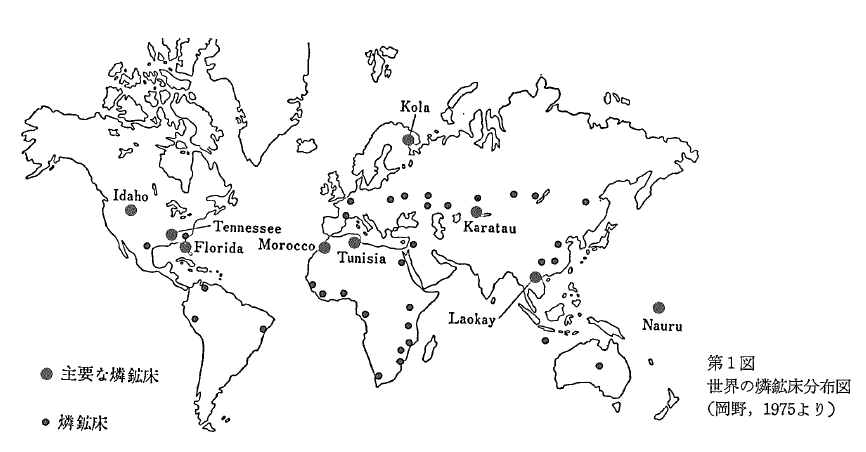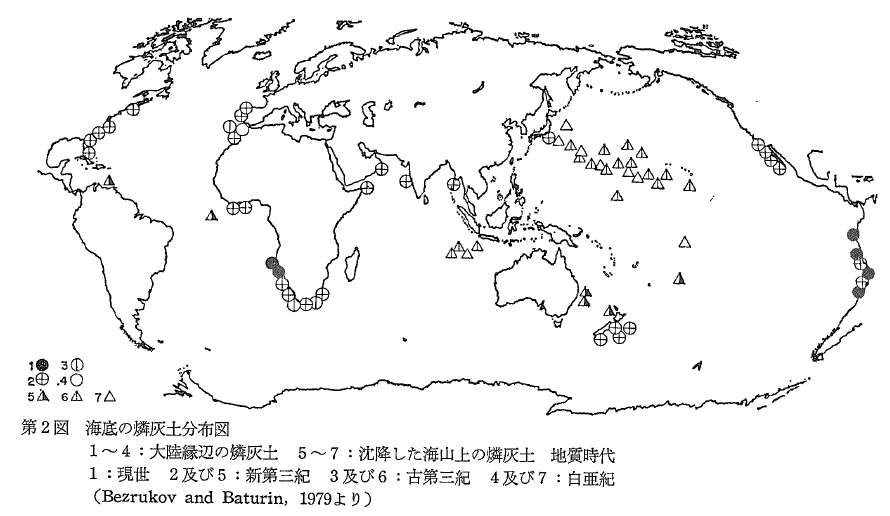Table 3c. Cathcart (1980) Summary
|
Type |
Reserves |
Resources |
|
(mmt) |
(mmt) |
|
Marine phosphoritea |
19,705 |
87,810 |
|
Igneous |
852 |
2,845 |
|
Total |
20,557 |
90,655 |
|
a. Marine phosphorite is assumed to be sedimentary
phosphate rock of marine origin. |
|
Table 5i. World Summary From Notholt, Sheldon and
Davidson (1989) (Tables 5a-h)
|
Continent/Region |
Resources |
Average P205 |
|
(mmt rock) |
(%) |
|
North America |
34,999 |
24 |
|
South America |
5,243 |
18 |
|
Africa |
67,016 |
26 |
|
Middle East |
15,642 |
21 |
|
Europe |
1,168 |
7 |
|
Asia |
13,947 |
24 |
|
USSR and MPR |
21,269 |
12 |
|
Australia, New Zealand and Oceania |
3,955 |
18 |
|
Total |
163,239 |
22.5 |
|
Table 7. USGS Phosphate Rock and Mineral Commodity
Summary, January 2010, Mine Production (2008,
2009) Reserves. IFDC Reserve and Resource Estimate
|
Country |
Mine Production |
USGS 2010 Reservesa |
IFDC Reservesb
(Product) |
IFDC Resourcesc |
|
2008 |
2009d |
|
|
(mmt) |
|
United States |
30.20 |
27.20 |
1,100 |
1,800 |
49,000 |
|
Australia |
2.80 |
2.50 |
82 |
82 |
3,500 |
|
Brazil |
6.20 |
6.00 |
260 |
400 |
2,800 |
|
Canada |
0.95 |
0.90 |
15 |
5 |
130 |
|
China |
50.70 |
55.00 |
3,700 |
3,700 |
16,800 |
|
Egypt |
3.00 |
3.30 |
100 |
51 |
3,400 |
|
Israel |
3.09 |
3.00 |
180 |
220 |
1,600 |
|
Jordan |
6.27 |
6.00 |
1,500 |
900 |
1,800 |
|
Morocco |
25.00 |
24.00 |
5,700 |
51,000 |
170,000e |
|
Russia |
10.40 |
9.00 |
200 |
500 |
4,300 |
|
Senegal |
0.70 |
0.00 |
80 |
50 |
250 |
|
South Africa |
2.29 |
2.30 |
1,500 |
230 |
7,700 |
|
Syria |
3.22 |
3.00 |
100 |
250 |
2,000 |
|
Togo |
0.80 |
0.80 |
60 |
34 |
1,000 |
|
Tunisia |
8.00 |
7.00 |
100 |
85 |
1,200 |
|
Other countries |
7.44 |
7.00 |
950 |
600f |
22,000g |
|
World total (rounded) |
161.00 |
158.00 |
16,000 |
60,000 |
290,000 |
a. See original publication for exact definition
of terms.
b. Reserves as usable or marketable product. See text for details.
c. Resources as unprocessed phosphate rock of varying grades
or concentrate. See text for details.
d. Estimated.
e. Including hypothetical resources based on the area limits
of the deposits, Morocco resources may be approximately
340,000 mmt
f. Includes data from Algeria, Finland, Peru and Saudi Arabia
(AI-Jalamid).
g. Includes data from Algeria, Angola, Finland, Kazakhstan, Peru
and Saudi Arabia. |
|
Table 8. Past World Phosphate Rock Reserve and
Resource Estimates Based on Author's Terminology
|
|
Phosphate Rock Resources |
Estimated Recoverable Product |
Reserves |
Reserve Base |
|
|
(mmt) |
|
Emigh (1972) |
|
|
1,200,000 |
|
|
Wells (1975) |
|
|
530,000 (30% P2O5) |
|
|
DeVoto and Stevens (1979) |
1,200,000 |
266,000 (〜30% P2O5) |
|
|
|
Cathcart (1980) |
91,000 |
|
21,000 (≧30% P2O5) |
|
|
Fantel et al. (1988) |
|
37,000 |
|
|
|
Notholt, Sheldon and Davidson (1989) |
163,000 (〜22.5% P2O5) |
|
|
|
|
USGS (2009) |
|
|
15,000a |
47,000b |
a. Originally described as phosphate rock that
could be produced at less than US $40/ton.
b. Originally described as phosphate rock that could be produced
at less than US $100Iton.
Emigh, GD. 1972. "World Phosphate Reserves - Are
There Really Enough," Engineering and Mining Journal,
April 1972, 173(4):90-95.
Wells, FJ. 1975. The Long-Ruln Availability of Phosphorus,
A Case Study in Milneral Resource Analysis, Resources for
the Future, Inc., Washington, D.C., The Johns Hopkins University
Press, 121 p.
DeVoto, R.H., and DN. Stevens. 1979. Uraniferous Phosphate
Resources and Technology and Economics of Uranium Recovery from
Phosphate Resources United States and Free World, 1979, Volume
I, Uraniferous Phosphate Resources, United States and Free World,
report submitted to the U.S. Department of Energy, Grand Junction,
Colorado, National Technical Information Services Document GJBXI1079VI,724
p.
Cathcart, J.B. 1980. "World Phosphate Reserves and
Resources," IN The Role oj Phosphorus in Agriculture,
pp. 1-18, ASA-CSSA-SSSA, Madison, Wisconsin.
Fantel, RJ., RJ. Hurdelbrink, DJ. Shields and R.L. Johnson.
1988. Phosphate Availability and Supply, a Minerals Availability
Appraisal, Information Circular 1987, United States Department
of the Interior, Bureau of Mines, 70 p.
Notholt, AJ.G., R.P. Sheldon and D.F. Davidson (Eds.).
1989. Phosphate Deposits of the World, Vol. 2, Phosphate
Rock Resources, Cambridge University Press, Cambridge, United
Kingdom, 566 p.
U.S. Geological Survey. 1996-2010. Mineral Commodity
Summaries, Phosphate Rock, U.S. Department of the Interior,
Washington, DC, U.S.A. |
|
/Image2476.gif)
/Image2477.gif)
/Image2478.gif)
/Image2479.gif)
/Image2480.gif)
/Image1008.gif)
/Image1009.gif)
/Image2508.gif)
/Image2509.gif)
/Image2511.gif)
/Image2512.gif)
/Image2510.gif)
/Image2513.gif)
/Image929.gif)
/Image2449.gif)
/Image2450.gif)
/Image998.gif)
/Image2507.gif)
/Image2459.gif)
/Image2472.gif)
/Image2460.gif)
/Image2461.gif)
/Image2462.gif)
/Image2463.gif)
/Image2470.gif)
/Image2471.gif)
/Image2464.gif)
/Image2465.gif)
/Image2466.gif)
/Image2467.gif)
/Image2468.gif)
/Image2469.gif)
/Image2487.gif)
/Image2488.gif)
/Image2489.gif)
/Image2490.gif)
/Image2491.gif)
/Image2492.gif)
/Image2493.gif)
/Image2494.gif)
/Image2495.gif)
/Image2473.gif)
/Image2475.gif)
/Image2474.gif)
/Image2481.gif)
/Image2482.gif)


/Image2359.gif)
/Image2358.gif)